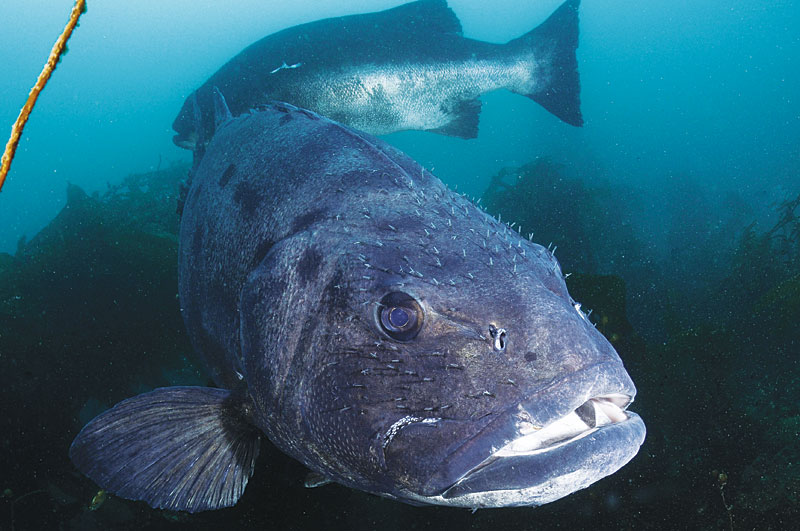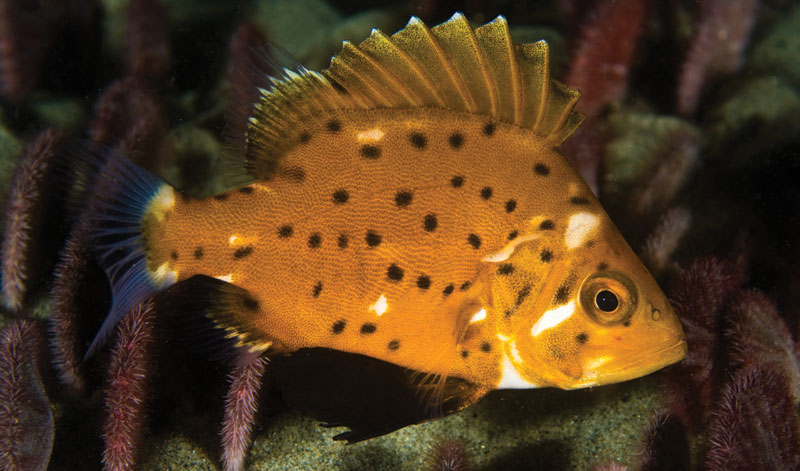For a few months each year, dive sites at Catalina, Anacapa, Santa Monica Bay, La Jolla Cove, and more, become inhabited with some rather large residents: The Giant Black Seabass (GBSB), Stereolepis gigas. Southern California is a home for these gentle creatures that were all but fished to the brink of extinction. In the late 1950’s and 60’s, hunting of these giant, docile fish was commonplace; preserved trophies and photographs can still be found in and around sportfishing shops and coastal restaurants.
But since they were placed on the watch list, these once rare fish are bouncing back again in large numbers. Never has the cliché “when the cows come home,” been more appropriate. There always seems to be an amount of time before the sightings begin where you question if they will actually come back. Not much is known in regards to migrating patterns, but I have noticed that their numbers are increasing. When they do return and sightings become regular, a collective gasp can be heard throughout the southland diving community.
Story and photos by Mike Bartick, Saltwaterphoto.com
Special Thanks to Sundiver International and July Wright
The best time of the year to dive with Giant Black Seabass in Southern California is June through mid-September, although sightings throughout the year are not unusual. GBSB enjoy divers and will often tag along behind you or your buddy. The bass like to hang out in depths ranging from 35-65 feet, making them perfect for new divers to experience firsthand. If encountered, remember that these are gentle, curious creatures that want nothing more than to have a closer look at you.
The Giant Black Seabassmoves into shallow waters during the summer months presumably to mate or spawn and congregate in numbers. They love to hang out in kelp patches and in dark shady spots, blending in with their surroundings as well as a 500-pound fish possibly could.
Recently, while on a mid-week trip to the Island of Catalina, we set up on a known GBSB haunt: Goat Harbor. The water was calm, blue, and begging for divers. I dropped in to see a smaller bat ray scamper across the sand. Then, from behind, buzzed the first GBSB of the day. Cruising with intention but calm, I followed him while setting up my camera. Eventually this smaller (I presumed male) GBSB led me right into a thick patch of kelp. The kelp stood straight up from a sandy slope with patches of bull kelp near the bottom. I approached quietly, knowing the larger female bass might be in there as well; they like to hang in the shadows to hide. GBSB always seem a bit skittish this early in the season, so I hunkered down and quietly began to scout around. Then I noticed three very large sea bass not far ahead of me. They noticed me too, as the two smaller male suitors got a bit restless. One nudged the female’s tale; the other swooped around and came right at me in a mating block. The second male followed suit and all three left in haste. That was definitely an aggressive show of power warning me that this girl was taken! I looked up and saw at least a dozen more GBSB amongst the kelp and in the water column, so I kicked out to join them.
The most effective approach turned out to be no approach at all, as I soon found out. The Giants scattered when I approached, so sitting still and letting them come to me seemed to work best. Several of the larger females with suitors in tow made some very close passes, and allowed me to shoot some “up close and personal” photos.
Back on the boat, I chatted with a couple of newly certified divers. I could hear the excitement in their voices. Seeing a GBSB on their first official dive, how incredible! It reminded me of my first experience with a GBSB. While diving at the Catalina dive park on a stormy February morning, I cruised along searching for nudibranchs. Feeling something present over my left shoulder, I looked up and into a giant eye curiously staring me down. I let out a gasp of bubbles and this huge fish took off with a loud baritone thud, returning just a few minutes later. That big guy followed me all over the dive park and back to the stairs. It’s this same docile nature that made the GBSB such an easy target for the taking. I can only imagine what it was like when the So-Cal waters were loaded with these wonderful creatures. Inevitably, after every visit to Goat Harbor, a diver or two will tell me they never saw the GBSB, or they think they saw one but were not able to confirm the sighting. Let me just clear the water on this subject: once you see a GBSB you will know, without question, that these bass are called “giant” for a reason. If you have never seen one of these beautiful fish in person, I urge you to call your favorite boat and get out there now; these guys aren’t here forever and timing is essential. Even though these giants may congregate in predictable places, it’s pure arrogance to assume they will be there for long.
Now get out there and have an adventure!
Story and photos by Mike Bartick. Visit his website at Saltwaterphoto.com.
Special Thanks to Sundiver International and July Wright
.


